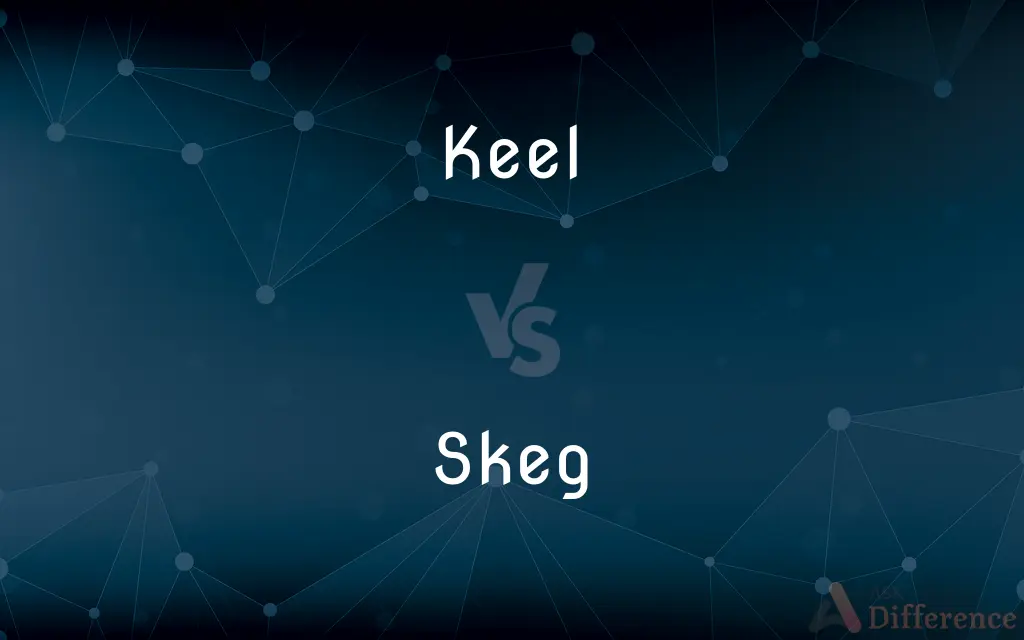Keel vs. Skeg — What's the Difference?
By Tayyaba Rehman & Urooj Arif — Updated on May 3, 2024
A keel is the structural backbone of a boat, crucial for stability and structural integrity, whereas a skeg is a smaller fin-like structure added to improve directional stability.

Difference Between Keel and Skeg
Table of Contents
ADVERTISEMENT
Key Differences
The keel of a boat serves as its principal structural element, running along the bottom from bow to stern. Whereas a skeg, often found on boats and surfboards, acts as a supplementary fin located near the stern.
Keels are integral to a boat’s design and directly contribute to its overall strength and stability in the water. On the other hand, skegs are not structural but are added to assist in steering and to protect the rudder from damage.
In sailing vessels, the keel plays a critical role in preventing the boat from being blown sideways by the wind, also aiding in the vessel’s ability to move forward through the water. Whereas the skeg does not contribute to wind resistance but helps in maintaining a straight course when moving.
Many modern boats combine both features for enhanced performance: the keel provides structural stability and wind resistance while the skeg aids in directional stability and protects the boat’s propellers or rudders.
In terms of maintenance and construction, the keel is a major consideration as it is a part of the boat’s initial design and construction, usually built with the hull. Skegs, however, can be added or modified relatively easily depending on the boat’s intended use or the water conditions it will face.
ADVERTISEMENT
Comparison Chart
Function
Provides structural support and stability.
Improves directional stability.
Location
Runs along the boat’s bottom.
Attached near the stern.
Contribution
Essential for balance and movement.
Non-essential, aids in navigation.
Design Importance
Integral to the boat’s design.
Add-on feature for specific needs.
Impact on Sailing
Critical for effective sailing.
Complementary to the keel’s function.
Compare with Definitions
Keel
In birds, the central ridge on the sternum to which flight muscles attach.
The keel is well-developed in flying birds.
Skeg
A fin projecting from the bottom of the hull to improve stability.
The skeg under the surfboard helps with directional control.
Keel
The central structural base of a vessel.
The ship's keel was laid down two years before its completion.
Skeg
Used in some vehicles to protect the differential gears.
The truck's skeg needs replacing after a rough terrain ride.
Keel
The act of keeling over or falling.
He keeled over in laughter.
Skeg
A protective device for the propeller of a boat.
The skeg shields the propeller from underwater debris.
Keel
Historically, a beam around which the hull of a ship is built.
The keel extends the entire length of the vessel.
Skeg
A term used in some regional dialects to refer to a blunt end.
The skeg of the tool is designed for pushing, not cutting.
Keel
To capsize or turn turtle in sailing.
The small boat nearly keeled over in the storm.
Skeg
A part of a kayak or similar watercraft used for navigation.
Adjusting the skeg can help the kayak maintain a straight path.
Keel
The keel is the bottom-most longitudinal structural element on a vessel. On some sailboats, it may have a hydrodynamic and counterbalancing purpose, as well.
Skeg
A skeg (or skegg or skag) is a sternward extension of the keel of boats and ships which have a rudder mounted on the centre line. The term also applies to the lowest point on an outboard motor or the outdrive of an inboard/outboard.
Keel
The lengthwise timber or steel structure along the base of a ship, supporting the framework of the whole, in some vessels extended downwards as a ridge to increase stability.
Skeg
A timber that connects the keel and sternpost of a ship.
Keel
A prow-shaped pair of petals present in flowers of the pea family.
Skeg
An arm extending to the rear of the keel to support the rudder and protect the propeller.
Keel
A flat-bottomed boat of a kind formerly used on the Tyne and Wear Rivers for loading ships carrying coal.
Skeg
A fin projecting from the bottom of an outboard motor, used to protect the propeller and to provide extra steering control.
Keel
(of a boat or ship) turn over on its side; capsize
It's going to take more wind to make this boat keel over
Skeg
A centerboard mounted near the stern of a kayak, used to improve directional stability in windy weather.
Keel
The principal structural member of a boat or ship, running along the center of the hull from bow to stern, to which the ribs are attached.
Skeg
A fin mounted near the tail of a surfboard, used to improve directional stability.
Keel
A projecting ridge or fin on the bottom of the hull of a boat or ship that improves directional control and is often weighted for added stability.
Skeg
(nautical) A fin-like structure to the rear of the keel of a vessel that supports the rudder and protects a propeller.
Keel
The principal structural member of an aircraft, resembling a ship's keel in shape and function.
Skeg
(nautical) A similar construction on a boat that acts as a keel.
Keel
A pair of united petals in certain flowers, as those of many members of the pea family.
Skeg
A fin that serves to stabilize a surfboard.
Keel
A sail-powered barge, especially one historically used on the rivers of northern England.
Skeg
A surfer; a person who leads a surfing lifestyle.
Keel
The load capacity of this barge.
Skeg
(obsolete) A sort of wild plum (Prunus spinosa or Prunus domestica subsp. insititia (syn. Prunus institia)).
Keel
A British unit of weight formerly used for coal, equal to about 21.2 long tons.
Skeg
(obsolete) A kind of oat.
Keel
To capsize or cause to capsize.
Skeg
(Northern English) A look or glance.
Keel
To make cool.
Skeg
A sort of wild plum.
Keel
(nautical) A large beam along the underside of a ship’s hull from bow to stern.
Skeg
A kind of oats.
Keel
(nautical) A rigid, flat piece of material anchored to the lowest part of the hull of a ship to give it greater control and stability.
Skeg
The after part of the keel of a vessel, to which the rudder is attached.
Keel
(aeronautics) In a dirigible, a construction similar in form and use to a ship's keel; in an aeroplane, a fin or fixed surface employed to increase stability and to hold the machine to its course.
Skeg
A brace that extends from the rear of the keel to support the rudderpost
Keel
(by extension) The rigid bottom part of something else, especially an iceberg.
Keel
(nautical) A type of flat-bottomed boat.
Keel
(zoology) The periphery of a whorl extended to form a more or less flattened plate; a prominent spiral ridge.
Keel
(botany) The two lowest petals of the corolla of a papilionaceous flower, united and enclosing the stamens and pistil; a carina.
Keel
(brewing) A broad, flat vessel used for cooling liquids; a brewer's cooling vat; a keelfat.
Keel
(Scotland) Red chalk; ruddle.
Keel
To collapse, to fall
He keeled over after having a stroke.
Keel
To traverse with a keel; to navigate.
Keel
To turn up the keel; to show the bottom.
Keel
To cool; make cool; to cool by stirring or skimming in order to keep from boiling over.
While greasy Joan doth keel the pot (Shakespeare)
Keel
To moderate the ardour or intensity of; assuage; to appease, pacify, or lessen.
Keel
To become cool; cool down.
Keel
To mark with ruddle.
Keel
Pronunciation spelling of kill
Keel
To cool; to skim or stir.
While greasy Joan doth keel the pot.
Keel
To traverse with a keel; to navigate.
Keel
To turn up the keel; to show the bottom.
Keel
A brewer's cooling vat; a keelfat.
Keel
A longitudinal timber, or series of timbers scarfed together, extending from stem to stern along the bottom of a vessel. It is the principal timber of the vessel, and, by means of the ribs attached on each side, supports the vessel's frame. In an iron vessel, a combination of plates supplies the place of the keel of a wooden ship. See Illust. of Keelson.
Keel
Fig.: The whole ship.
Keel
A barge or lighter, used on the Tyne for carrying coal from Newcastle; also, a barge load of coal, twenty-one tons, four cwt.
Keel
The two lowest petals of the corolla of a papilionaceous flower, united and inclosing the stamens and pistil; a carina. See Carina.
Keel
A projecting ridge along the middle of a flat or curved surface.
Keel
In a dirigible, a construction similar in form and use to a ship's keel; in an aëroplane, a fin or fixed surface employed to increase stability and to hold the machine to its course.
Keel
One of the main longitudinal beams (or plates) of the hull of a vessel; can extend vertically into the water to provide lateral stability
Keel
Walk as if unable to control one's movements;
The drunken man staggered into the room
Common Curiosities
What is the primary purpose of a keel on a boat?
The primary purpose of a keel is to provide stability and structural integrity.
Is it possible to add a skeg to a boat that doesn't have one?
Yes, a skeg can often be added to boats to improve steering stability or protect other components.
Can a boat have both a keel and a skeg?
Yes, many boats are designed with both a keel and a skeg to maximize stability and navigational efficiency.
Are keels present on all types of boats?
Most large and sailing vessels have keels, but some small or specialized boats might not require a keel.
How does a skeg improve a boat's performance?
A skeg improves a boat's performance by enhancing its directional stability and protecting vital components like the rudder.
What materials are commonly used to construct keels and skegs?
Keels and skegs are typically made from metals such as steel or composites like fiberglass, depending on the boat's design and use.
What is the difference between a skeg and a rudder?
A skeg is a fixed fin used for stability, while a rudder is a movable structure used for steering the boat.
How do keels and skegs affect the handling of a boat?
Keels significantly affect a boat's balance and sailing capabilities, while skegs mainly influence the boat’s tracking and directional stability.
What happens if a boat's keel is damaged?
Damage to a boat's keel can compromise its structural integrity and stability, potentially making it unsafe to operate.
Can the shape of a skeg affect a boat's performance?
Yes, the shape and size of a skeg can significantly impact how well it improves directional stability and protects other components.
Share Your Discovery

Previous Comparison
Affinity vs. Consanguinity
Next Comparison
Mindset vs. MindframeAuthor Spotlight
Written by
Tayyaba RehmanTayyaba Rehman is a distinguished writer, currently serving as a primary contributor to askdifference.com. As a researcher in semantics and etymology, Tayyaba's passion for the complexity of languages and their distinctions has found a perfect home on the platform. Tayyaba delves into the intricacies of language, distinguishing between commonly confused words and phrases, thereby providing clarity for readers worldwide.
Co-written by
Urooj ArifUrooj is a skilled content writer at Ask Difference, known for her exceptional ability to simplify complex topics into engaging and informative content. With a passion for research and a flair for clear, concise writing, she consistently delivers articles that resonate with our diverse audience.
















































